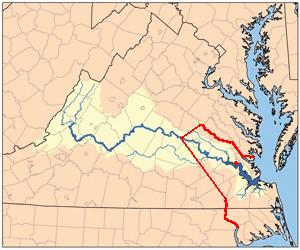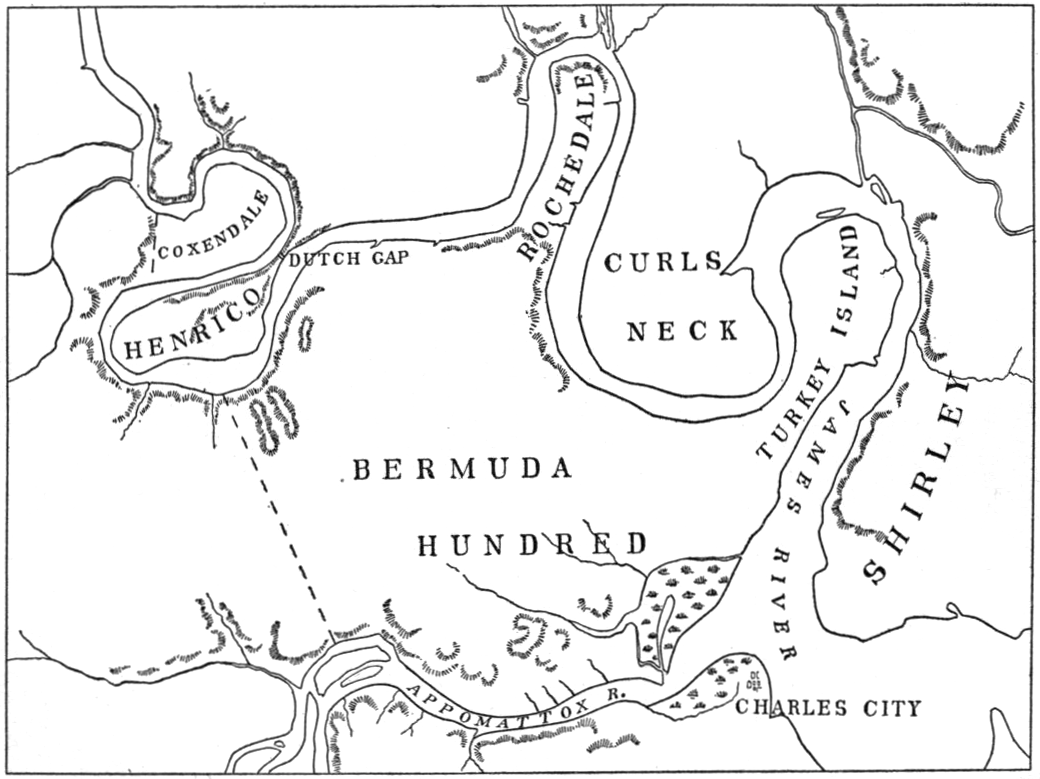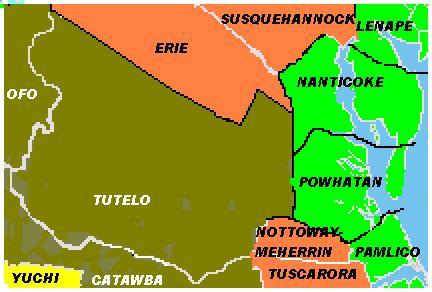|
Appomattoc
The Appomattoc (also spelled Appamatuck, Apamatic, and numerous other variants) were a historic tribe of Virginia Indians speaking an Algonquian language, and residing along the lower Appomattox River, in the area of what is now Petersburg, Colonial Heights, Chesterfield and Dinwiddie Counties in present-day southeast Virginia. The Appomattoc were affiliated with the estimated 30 tribes of the Powhatan Confederacy, who controlled the area then known as Tenakomakah, present-day Tidewater Virginia. According to William Strachey, the Appomattoc were one of four subtribes within the original inheritance of Chief Powhatan, before he incorporated the other tribes into his Confederacy, and were said to be closely connected with the Powhatan royal line. History The Appomattoc first encountered English explorers on May 8, 1607, when a party led by Christopher Newport reached one of their villages at the mouth of the Appomattox River (it was shown as "Mattica" on the 1608 Tindall m ... [...More Info...] [...Related Items...] OR: [Wikipedia] [Google] [Baidu] |
Oppussoquionuske
Opossunoquonuske (variant forms: Oppussoquionuske or Opposunoquonuske), (birthdate unknown – 1610) was a Weroansqua of an Appomattoc town near the mouth of the Appomattox River. Weroansqua (or Weroance) is an Algonquian word meaning leader or commander among the Powhatan confederacy of Virginia coast and Chesapeake Bay region. She was known as the queen of Appamatuck, The community she led was large enough to provide an estimated twenty warriors to the Powhatan Confederacy. Native women leaders appear in numerous colonial records, and Opossunoquonuske is among that list. Just as Hernando de Soto met a woman he called the Lady of Cofitachequi, John Smith mentions Opossunoquonuske, “Queen of Appomattoc” Even as colonization curtailed more direct forms of political and military leadership for women, later records attest to the ways in which many Native women maintained sociocultural authority. Early descriptions Various English settlers gave the first recorded descriptions ... [...More Info...] [...Related Items...] OR: [Wikipedia] [Google] [Baidu] |
Anglo-Powhatan War
The AngloPowhatan Wars were three wars fought between settlers of the Virginia Colony and Algonquin Indians of the Powhatan Confederacy in the early seventeenth century. The first war started in 1609 and ended in a peace settlement in 1614. The second war lasted from 1622 to 1626. The third war lasted from 1644 until 1646 and ended when Opechancanough was captured and killed. That war resulted in a defined boundary between the Indians and colonial lands that could only be crossed for official business with a special pass. This situation lasted until 1677 and the Treaty of Middle Plantation which established Indian reservations following Bacon's Rebellion. Early conflict The settlement at Jamestown, Virginia (May 1607), was within the territory of the powerful Chief Wahunsunacawh, known to the colonists as Chief Powhatan. The area was quite swampy and ill-suited to farming, and Powhatan wanted Captain John Smith and the colonists to forsake the swamp and live in one of his satel ... [...More Info...] [...Related Items...] OR: [Wikipedia] [Google] [Baidu] |
Bermuda Hundred
Bermuda Hundred was the first administrative division in the English colony of Virginia. It was founded by Sir Thomas Dale in 1613, six years after Jamestown. At the southwestern edge of the confluence of the Appomattox and James Rivers opposite City Point, annexed to Hopewell, Virginia in 1923, Bermuda Hundred was a port town for many years. The terminology "Bermuda Hundred" also included a large area adjacent to the town. In the colonial era, " hundreds" were large developments of many acres, arising from the English term to define an area which would support 100 homesteads. The port at the town of Bermuda Hundred was intended to serve other "hundreds" in addition to Bermuda Hundred. The area of the peninsula between the James and Appomattox Rivers on which Bermuda Hundred is located was part of the Bermuda Hundred Campaign of May 1864 during the American Civil War. No longer a shipping port, Bermuda Hundred is now a small community in the southeastern portion of Chest ... [...More Info...] [...Related Items...] OR: [Wikipedia] [Google] [Baidu] |
Tenakomakah
Tsenacommacah (pronounced in English; "densely inhabited land"; also written Tscenocomoco, Tsenacomoco, Tenakomakah, Attanoughkomouck, and Attan-Akamik) is the name given by the Powhatan people to their native homeland, the area encompassing all of Tidewater Virginia and parts of the Eastern Shore. More precisely, its boundaries spanned by from near the south side of the mouth of the James River all the way north to the south end of the Potomac River and from the Eastern Shore west to about the Fall Line of the rivers.Rountree, Helen C. and E. Randolph Turner III. Before and After Jamestown: Virginia's Powhatans and Their Predecessors. Gainesville: University Press of Florida, 2002. The term ''Tsenacommacah'' comes from the Powhatan language, and means “densely inhabited land.” History Origins and contact The Powhatan were part of a powerful Chiefdom of Virginia Indian tribes, also known as the Powhatan Confederacy, that spoke an Algonquian language. The chief of th ... [...More Info...] [...Related Items...] OR: [Wikipedia] [Google] [Baidu] |
Virginia Indians
The Native American tribes in Virginia are the indigenous tribes who currently live or have historically lived in what is now the Commonwealth of Virginia in the United States of America. All of the Commonwealth of Virginia used to be Virginia Indian territory. Indigenous peoples have occupied the region for at least 12,000 years. Their population has been estimated to have been about 50,000 at the time of European colonization. At contact, Virginian tribes belonged to tribes and spoke languages belonging to three major language families: roughly, Algonquian along the coast and Tidewater region, Siouan in the Piedmont region above the Fall Line, and Iroquoian in the interior, particularly the mountains. About 30 Algonquian tribes were allied in the powerful Powhatan paramount chiefdom along the coast, which was estimated to include 15,000 people at the time of English colonization. Few written documents assess the traditions and quality of life of some of the various early t ... [...More Info...] [...Related Items...] OR: [Wikipedia] [Google] [Baidu] |
Chief Powhatan
Powhatan ( c. 1547 – c. 1618), whose proper name was Wahunsenacawh (alternately spelled Wahunsenacah, Wahunsunacock or Wahunsonacock), was the leader of the Powhatan, an alliance of Algonquian-speaking Native Americans living in Tsenacommacah, in the Tidewater region of Virginia at the time when English settlers landed at Jamestown in 1607. Powhatan, alternately called "King" or "Chief" Powhatan by English settlers, led the main political and military power facing the early colonists, and was probably the older brother of Opechancanough, who led attacks against the settlers in 1622 and 1644. He was the father of Matoaka (Pocahontas). Name In 1607, the English colonists were introduced to Wahunsenacawh as Powhatan and understood this latter name to come from Powhatan's hometown near the falls of the James River near present-day Richmond, Virginia.Huber, Margaret Williamson (January 12, 2011)"Powhatan (d. 1618)" [...More Info...] [...Related Items...] OR: [Wikipedia] [Google] [Baidu] |
Powhatan Confederacy
The Powhatan people (; also spelled Powatan) may refer to any of the indigenous Algonquian people that are traditionally from eastern Virginia. All of the Powhatan groups descend from the Powhatan Confederacy. In some instances, The Powhatan may refer to one of the leaders of the people. This is most commonly the case in historical records from English colonial accounts.Waugaman, Sandra F. and Danielle Moretti-Langholtz, Ph.D. ''We're Still Here: Contemporary Virginia Indians Tell Their Stories''. Richmond: Palari Publishing, 2006 (revised edition). The Powhatans have also been known as Virginia Algonquians, as the Powhatan language is an eastern- Algonquian language, also known as Virginia Algonquian. It is estimated that there were about 14,000–21,000 Powhatan people in eastern Virginia, when English colonists established Jamestown in 1607. In the late 16th and early 17th centuries, a ''mamanatowick'' (paramount chief) named Wahunsenacawh created an organization by aff ... [...More Info...] [...Related Items...] OR: [Wikipedia] [Google] [Baidu] |
Appomattox River
The Appomattox River is a tributary of the James River, approximately long,U.S. Geological Survey. National Hydrography Dataset high-resolution flowline dataThe National Map, accessed April 1, 2011 in central and eastern Virginia in the United States, named for the Appomattocs Indian tribe who lived along its lower banks in the 17th century. It drains a cotton and tobacco-growing region of the Piedmont and coastal plain southwest of Richmond. The English colonists in Virginia at first tried to rename the Appomattox as the "Bristoll River", however this name did not catch on, while the native one did. There are numerous historical spelling variants, such as Apamatuck, Apamutiky, Appamattuck, Appomattake, and Apumetecs, among others. Course The Appomattox River rises in the middle of a field near State Route 656 (Horseshoe Road) in the Piedmont of northeastern Appomattox County, approximately northeast of the town of Appomattox. It flows generally southeast through the Appom ... [...More Info...] [...Related Items...] OR: [Wikipedia] [Google] [Baidu] |
Virginia Indian
The Native American tribes in Virginia are the indigenous tribes who currently live or have historically lived in what is now the Commonwealth of Virginia in the United States of America. All of the Commonwealth of Virginia used to be Virginia Indian territory. Indigenous peoples have occupied the region for at least 12,000 years. Their population has been estimated to have been about 50,000 at the time of European colonization. At contact, Virginian tribes belonged to tribes and spoke languages belonging to three major language families: roughly, Algonquian along the coast and Tidewater region, Siouan in the Piedmont region above the Fall Line, and Iroquoian in the interior, particularly the mountains. About 30 Algonquian tribes were allied in the powerful Powhatan paramount chiefdom along the coast, which was estimated to include 15,000 people at the time of English colonization. Few written documents assess the traditions and quality of life of some of the various early t ... [...More Info...] [...Related Items...] OR: [Wikipedia] [Google] [Baidu] |
Powhatan
The Powhatan people (; also spelled Powatan) may refer to any of the indigenous Algonquian people that are traditionally from eastern Virginia. All of the Powhatan groups descend from the Powhatan Confederacy. In some instances, The Powhatan may refer to one of the leaders of the people. This is most commonly the case in historical records from English colonial accounts.Waugaman, Sandra F. and Danielle Moretti-Langholtz, Ph.D. ''We're Still Here: Contemporary Virginia Indians Tell Their Stories''. Richmond: Palari Publishing, 2006 (revised edition). The Powhatans have also been known as Virginia Algonquians, as the Powhatan language is an eastern- Algonquian language, also known as Virginia Algonquian. It is estimated that there were about 14,000–21,000 Powhatan people in eastern Virginia, when English colonists established Jamestown in 1607. In the late 16th and early 17th centuries, a ''mamanatowick'' (paramount chief) named Wahunsenacawh created an organization by affi ... [...More Info...] [...Related Items...] OR: [Wikipedia] [Google] [Baidu] |
Copper
Copper is a chemical element with the symbol Cu (from la, cuprum) and atomic number 29. It is a soft, malleable, and ductile metal with very high thermal and electrical conductivity. A freshly exposed surface of pure copper has a pinkish-orange color. Copper is used as a conductor of heat and electricity, as a building material, and as a constituent of various metal alloys, such as sterling silver used in jewelry, cupronickel used to make marine hardware and coins, and constantan used in strain gauges and thermocouples for temperature measurement. Copper is one of the few metals that can occur in nature in a directly usable metallic form ( native metals). This led to very early human use in several regions, from circa 8000 BC. Thousands of years later, it was the first metal to be smelted from sulfide ores, circa 5000 BC; the first metal to be cast into a shape in a mold, c. 4000 BC; and the first metal to be purposely alloyed with another metal, tin, to create ... [...More Info...] [...Related Items...] OR: [Wikipedia] [Google] [Baidu] |
Werowocomoco
Werowocomoco was a village that served as the headquarters of Chief Powhatan, a Virginia Algonquian political and spiritual leader when the English founded Jamestown in 1607. The name ''Werowocomoco'' comes from the Powhatan ''werowans'' (''weroance''), meaning "leader" in English; and ''komakah'' (-comoco), "settlement". The town was documented by English settlers in 1608 as located near the north bank of the York River in what is now Gloucester County. It was separated by that river and the narrow Virginia Peninsula from the English settlement of Jamestown, located on the James River. Powhatan's Chimney at Wicomico, a site of historical ruins associated with a house purported to have been built for Powhatan, was long thought to have been the site of this capital. Its probable true site was tentatively identified by archaeologists in 2003 at a site on Purtan Bay, further west on the York River. [...More Info...] [...Related Items...] OR: [Wikipedia] [Google] [Baidu] |







